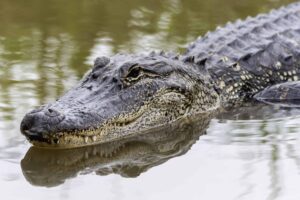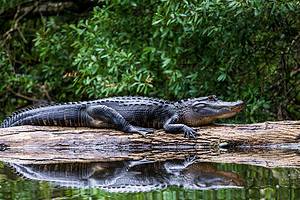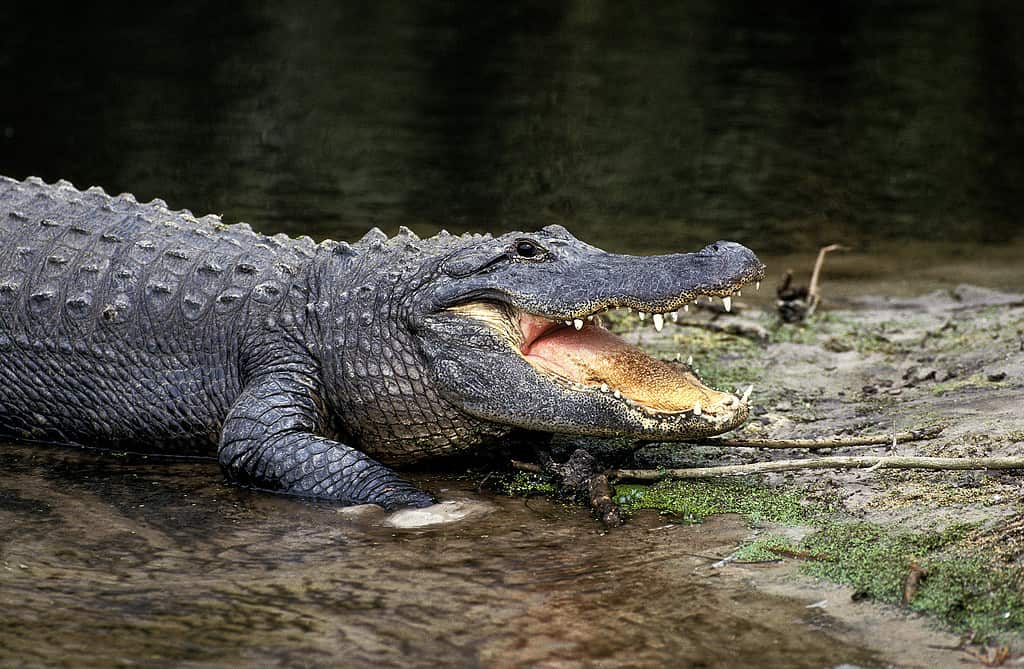
The American alligator,
Alligator mississipiensis, is an alligator species native to North America.
©slowmotiongli/iStock via Getty Images
Buying a home on Lake Lochloosa sounds like a good investment for anyone thinking of moving to Florida. Stories of excellent bass fishing and beautiful walking trails are an easy choice for those ready to settle down and live a quiet life.
However, Lake Lochloosa has secrets lurking along its shoreline. The number of alligators living in the lake has potential home buyers reconsidering their purchase. This article provides a glimpse of the alligator population living in Lake Lochloosa, along with other hazards that have diminished the lake’s great name.
Lake Lochloosa, Florida

Florida is home to dozens of lakes, like Lake Lochloosa.
©Steve Saccio/iStock via Getty Images
Lake Lochloosa is five miles south of Hawthorn and very close to the town of Lochloosa, Florida. The majority of the lake has forests, wetlands, and other lakes surrounding its borders. The state uses the remaining land for agriculture and residential housing.
Lake Lochloosa spans approximately 6,100 acres, with the deepest part of the lake measuring 10 feet deep. The Lake Lochloosa Wildlife Management teams protect the area and all wildlife from poaching, hunting, and urbanization. The management team posts signs and follows up on wildlife encounters or alligator nuisance reports.
What is So Special About Lake Lochloosa, Florida
The lake is well-known as a popular fishing spot for bass. Residents with lakefront property can dock their boats on their personal piers and fish at their leisure, with proper permits from the Florida Fish Wildlife Conservation Commission (FWC).
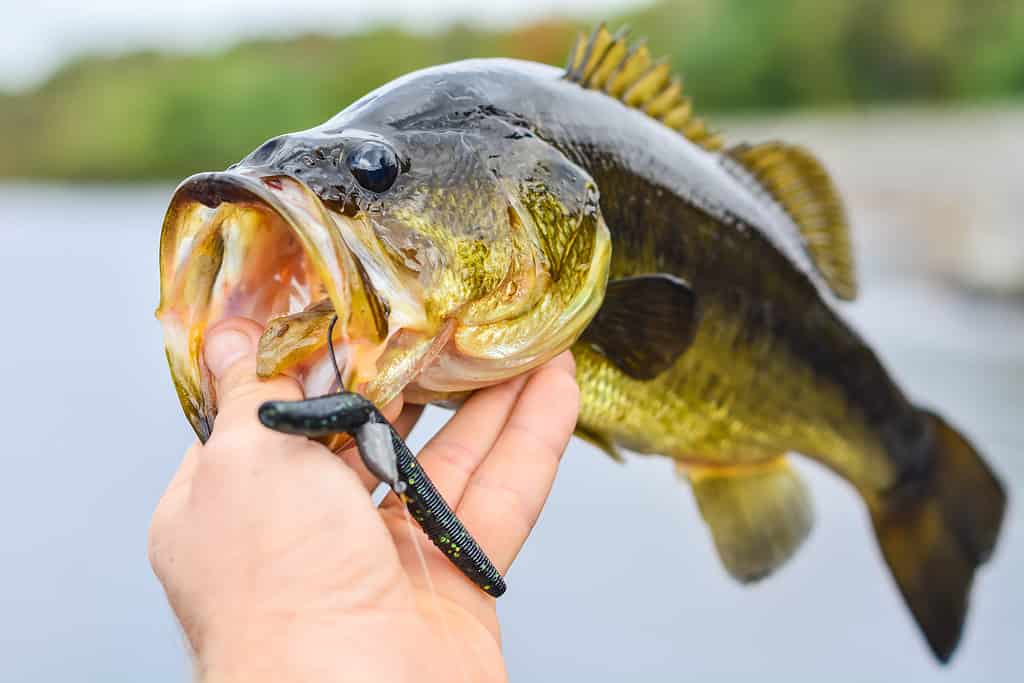
Largemouth bass are a popular sporting fish that is easily available in Lake Lochloosa.
©michal dziekonski/iStock / Getty Images Plus via Getty Images
Popular fish found in Lake Lochloosa are:
- Largemouth bass
- Warmouth
- Bluegill
- Redear sunfish
- Black crappie
Lake Lochloosa has 450 feet of undeveloped shoreline with a boardwalk for nature walks, wildlife viewing, and outdoor activities.
Do Alligators live in Lake Lochloosa?
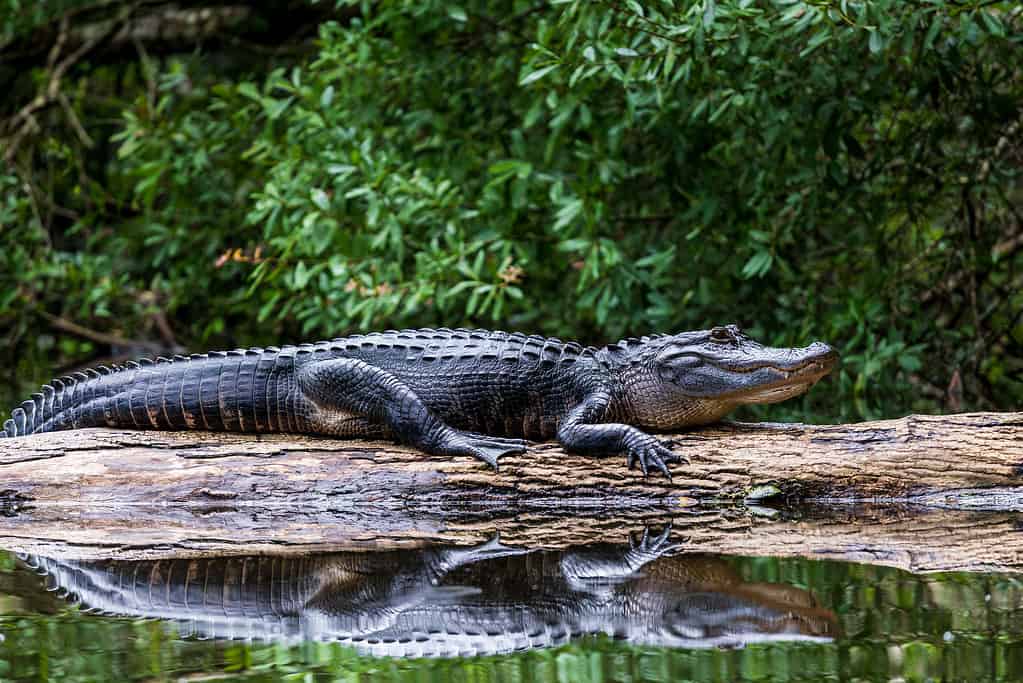
Distinguish juvenile American alligators by their smaller size compared to mature alligators.
©Joe Pearl Photography/iStock via Getty Images
Approximately 1.2 million alligators live in Florida. They inhabit nearly all sources of freshwater from rivers, lakes, bogs, and swamps. Buying a house in Florida means being comfortable with the fact that gators might be lurking nearby.
Residents living on Lake Lochloosa report sightings of alligators every week. Resident Marc Wilson bought a home in 2000 to enjoy a quiet life fishing and relaxing. Wilson reported to local news outlets that he spots alligators under his and neighbors’ docks often, typically resting within the foliage. Stomping on the decks and pier chases them away, but they often return to sunbathe.
Wilson reports nuisance alligators to the Statewide Nuisance Alligator Hotline. Officials then trap and remove them to limit potential gator attacks.
What Type of Alligators Live in Lake Lochloosa?
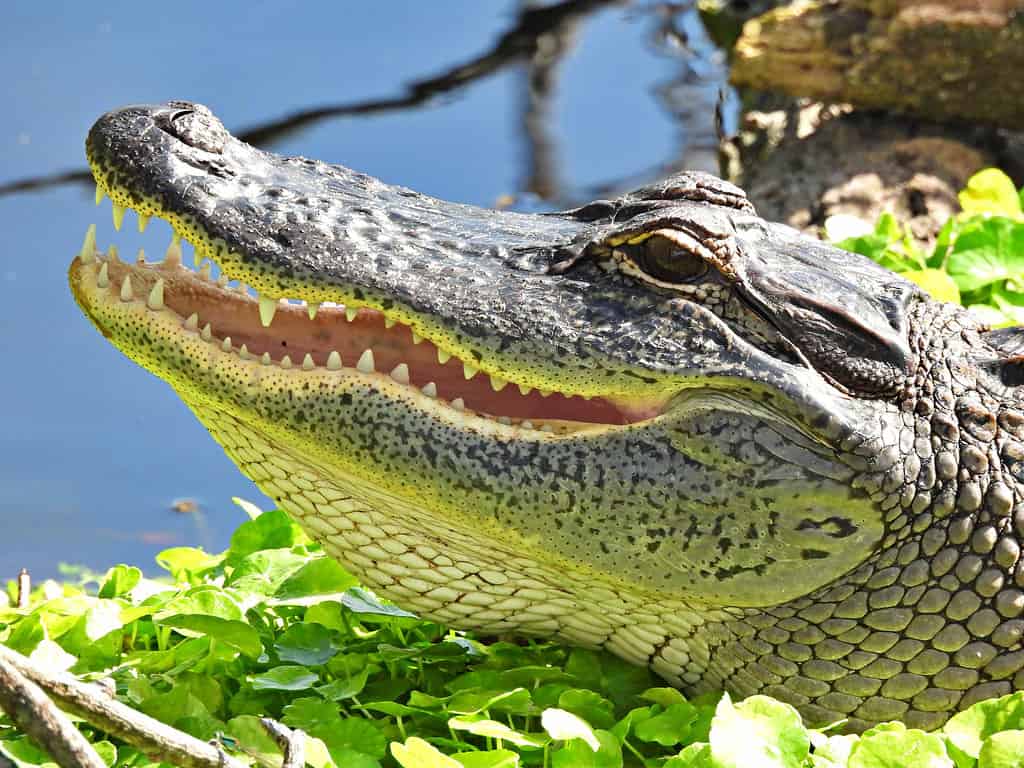
American alligators enjoy lying in foliage to better camouflage their bodies.
©passion4nature/iStock via Getty Images
American alligators are the primary alligator species living in Florida. The American alligators (Alligator mississippienis) are large crocodilians that naturally inhabit North America. A mature American alligator can reach nearly 12 feet long and weigh nearly 1,000 pounds. Gators can live for 30-50 years in the wild, while in captivity, alligators can live up to 70 years.
You can easily distinguish them from other crocodilian species by their broad and flat snouts and dark brown to black colored bony scales called scutes.
American alligators are cold-blooded reptiles that need external sources of heat to stay warm. They lounge on shorelines in sunny areas to absorb sunlight, using it to regulate their body temperature and digest food.
What Do American Alligators Eat
American alligators eat at night, making use of their dark scutes to blend into their surroundings. They are not picky eaters, willing to snap and eat anything they can grasp within their large maw.
An American alligator’s diet typically consists of:
- Fish
- Small mammals
- Birds
- Amphibians
- Invertebrates
How Do Alligators Catch Prey

Alligators are capable of catching prey underwater without drowning due to special throat glands.
©6381380/iStock via Getty Images
Alligators are opportunistic ambush predators, lurking just below the surface of the water and watching prey come to the lake to drink. Then, the gator dips below the surface of the water, inching its way close to the unsuspecting prey. Once close enough, the alligator propels itself out of the water, using its powerful jaws to clamp down on the prey and drag it into the water.
American alligators’ jaws can exert 2000 pounds of force per square inch on a target. For context, human jaws have 120 pounds of force per square inch.
Next, after dragging the prey into the water, the alligator performs a “death roll,” spinning rapidly. A death roll can easily tear off limbs from large animals.
Finally, the gator swallows broken off pieces of meat whole and repeats the bite-and-death roll process. Alligators will swallow rocks and stones to help break down bones for easier digestion.
Interestingly, alligators have evolved to replace their teeth as they age. It is common for alligators and crocodiles to lose teeth due to rotting meat damaging the roots of their teeth. New teeth replace the old ones within a few weeks to allow the reptile to continue thriving in the wild.
Alligator Protection Laws in Lake Lochloosa
American alligators are a Threatened species. Despite millions of alligators inhabiting the entirety of Florida, populations experienced declining numbers in the early 70s.
Destruction and urbanization of the native wetlands crippled the American alligator reproduction cycle. Without proper regulations in place, the American alligator population decreased to the point of endangerment.
The Endangered Species Act protected the alligator population and their habitat, allowing the species to thrive. In 1987, conservationists removed the American alligator from the Endangered species list. However, it is still protected under the FWC. Hunting and poaching alligators is forbidden.
How Do Residents Deal with Alligators in Lake Lochloosa
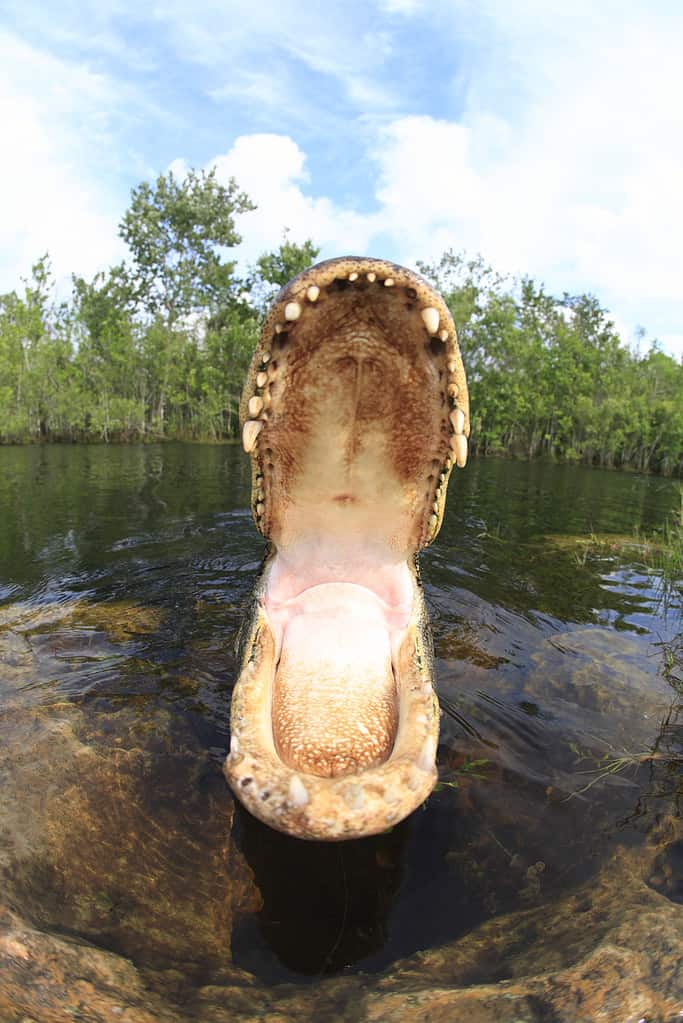
Alligators are very territorial and will hiss and bite at anyone near their territory.
©THIERRY EIDENWEIL/iStock via Getty Images
Florida has a Statewide Alligator Nuisance Program, which allows residents to contact a toll-free number to report a nuisance alligator.
A nuisance alligator is a gator that is over 4 feet long and capable of posing a threat to people, pets, or property. Any alligators under 4 feet are not nuisance gators and FWC laws protect them as natural wildlife.
The program’s registered alligator trappers catch any alligators matching the nuisance requirements. Residents can apply to be trappers on the FWC website.
How To Keep Safe from Alligators in Lake Lochloosa
The best way to keep safe from nuisance and wild alligators is to be smart and pay attention by following these guidelines:
- Contact Authorities: Call the local police, wildlife offices, or the nuisance program to inform the proper authorities of a potentially threatening alligator in the area.
- Do Not Feed: Feeding wild alligators will condition them to associate humans with food. This will remove their fear of humans, increasing the chances of an alligator attack. Keep food bins tightly closed and do not try to feed alligators of any size.
- Do Not Approach: Alligators are territorial animals and will snap or perform false charges when irritated. Leave them alone.
- Watch Pets and Children: Know where pets and children are at all times. Alligators are opportunistic feeders and will chomp at small prey for a quick meal. Small dogs and young children playing in the water are easy targets for a medium or large-size alligator.
- Run Away: Escape the situation when confronting an alligator. Alligators can run up to 15 miles per hour, but most often will perform a false charge to chase away bigger threats. Alligators and reptiles must conserve their energy to digest properly and regulate their bodies. Fleeing the vicinity will keep you safe. The alligator will remain in its territory rather than try to chase a large target.
- Fight if Necessary: This should only be applied during an alligator attack, when fighting back is the best chance of survival. Aiming for vulnerable spots like the eyes, throat, and neck may cause the gator to release you and flee. Grab an object and force it down the gator’s throat to trigger a gag reflex. Once you have escaped the gator’s clutches, seek immediate medical attention and report the incident to the Alligator Nuisance Program.
How to Spot Alligators in Lake Lochloosa
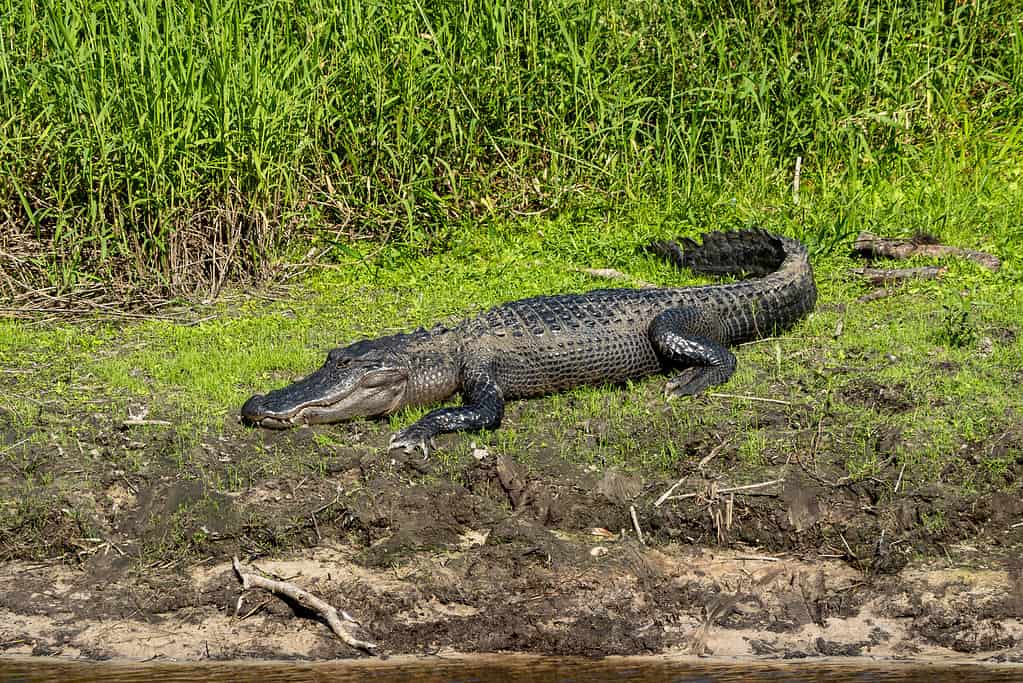
Alligators often sunbathe on shorelines to keep themselves warm and digest meals.
©FlagtailsPhotography/iStock via Getty Images
Finding an alligator around Lake Lochloosa should not be too difficult. Even if they blend into the surroundings, alligators can be easily located in a few ways.
- Search the Shoreline: Alligators will lie on shorelines for hours to absorb sunlight to warm their bodies. Scan the horizon during the day to find alligators lounging in the sun and resting.
- Shallow and Weeded Areas: Alligators use foliage and murky water to camouflage their bodies. Look in shallow areas and places with heavy plant life to spot an alligator hiding amid the greenery.
- Listen for Sounds: Alligators make hissing and bellowing sounds throughout the year. A hissing sound indicates a very angry alligator is nearby and it is time to leave the area. Bellowing is used as a mating call to attract females and frighten rival males.
Alligators are native to Florida, meaning they live in Lake Lochloosa as well. They are part of the state’s natural ecosystem, so living with them is a requirement of living in the region. By paying attention and knowing what to look for, living alongside these powerful reptiles is as simple as living among squirrels and birds.
Thank you for reading! Have some feedback for us? Contact the AZ Animals editorial team.






